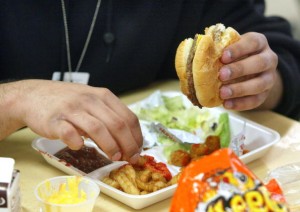Mailbag: Did Media Hype Fuel Debate Over Beef Filler In School Lunches?
We waded into the debate last week over a kind of beef product found in meals served in schools — a debate that may have flared only because of a nauseating nickname for the product: “pink slime.”
We wrote the ammonia-treated beef filler, which industry says consists of meat that couldn’t be previously removed with a knife, has become a centerpiece in the latest round of a debate over the cost and nutritional value of school lunches.
Several commenters pointed out the term “pink slime” is a euphemism critics coined for the product, designed to elicit a response from readers… and the media.
Georgiaprof writes:
The term “slime” is a complete misnomer and I presume is used by some news media to add sensationalism to an otherwise non-story. The fact is that the product is not slimy at all. It’s usually found in firm cylinders and looks and feels like regular ground beef except it’s a lighter red. The ammonia that’s lightly sprayed over it is nothing new to meats of all kinds and is often present in vegetable products as well… I don’t understand why the news media has decided to attack this product, but I can guess… the term PINK SLIME sounds scary and adds a strident punch to a story that otherwise has no news value at all.
Commenter ‘pdh’ concurs:
I see zero evidence this stuff is any worse for you than the hamburger its mixed with. Why not do a story on all the other food additives — the stuff that goes into hot dogs and bacon and cold cuts? Or do you just have to jump when someone comes up with the flavor of the week that we’re all supposed to get in a tizzy about?
Other commenters weren’t as concerned about media sensationalism as they were about the practical problems that make current school lunch offerings — burgers, fries, chicken fingers — so popular.
Commenter ‘md’ writes:
It may seem cheaper, but it is also easier — throw some patties on a sheet and through it in the oven. So there is a fight at staff level who say they don’t have time. There are solutions. Growing up, moms volunteered once a quarter to help prepare and serve lunch.
Terry32792 says the problem doesn’t start on the lunch line — it starts at home:
The change in menu will take much longer than we like to wait for results. Our school attempts to include fresh vegetables and salads but much of it ends up in the waste bins. Teaching healthy eating habits has to start well before the children go to school.
Keep your comments coming!

